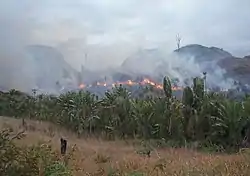Oasification
In hydrology, oasification is the antonym to desertification by soil erosion. This technique has limited application and is normally considered for much smaller areas than those threatened by desertification.

To help the oasification process, engineers aim to develop a thriving dense woody plant cover to redress the hydrological, edaphic and botanical degradation affecting a slope. This is done through appropriate soil preparation and the introduction of suitable plant species. It is also necessary to make adequate water harvesting systems—ideally taking advantage of the degradation process of the slope, collecting runoff water in ponds around the sites to be forested.
The term "oasification" was coined in 1999 by Andrés Martínez de Azagra Paredes, PhD Forest Engineer and professor on Hydraulics and Forest Hydrology at E.T.S. of Agroforestry Engineering in Palencia, University of Valladolid, Spain.
In oasification, soil and nutrient harvesting are regarded as fundamental component parts in the reclamation process of a degraded slope. Besides harvesting water, oasification preserves and accumulates soil and nutrients, helping to control water erosion—a common problem in dry climates. Ludwig et al. (1997) reported about sloping areas under semiarid conditions in Australia where the landscape is naturally divided into source and sink zones (surface runoff and run-on areas), which are sometimes reclaimed by plant species through retention of water soil and litter.
A common approach is the planting of various common horticulturally significant trees, which "are adapted to dry environments...these plants act as windbreaks and the extensive root network binds the soil thus reducing water erosion especially at the beginning of the rainy season when soil cover is at its lowest. Deciduous activity returns large amounts of organic matter to the soil in the form of leaf material which in tum support more vegetation biomass, and hence more soil cover and consequently erosion control. Eventually, ecosystems are reclaimed and desertification controlled."[1] Some of the trees deployed in this way include olive, cashew, date palm, fig, guava, mango, tamarind, pomegranate, papaya, lasoda, and jojoba.[1] Drought-tolerant legumes that provide additional biomass and fix nitrogen include green gram (Phaseolus aureus), black gram (Vigna mungo), chickpea (Cicer arictinum), cowpea (Vigna unguiculata), and lentil (Lens esculenta).[1]
References
- Pasternak, Dov; Schlissel, Arnold, eds. (2001). Combating Desertification with Plants. Boston, MA: Springer US. pp. 35–39. doi:10.1007/978-1-4615-1327-8. ISBN 978-1-4613-5499-4.
- Martínez de Azagra Paredes, A. (1999): El modelo hidrológico MODIPÉ. Montes, 55: 77 – 82
- Ludwig, J.; Tongway, D.; Freudenberger, D.; Noble, J. y Hodgkinson, K. (1997): Landscape ecology. Function and management. CSIRO. Collingwood (Australia)
